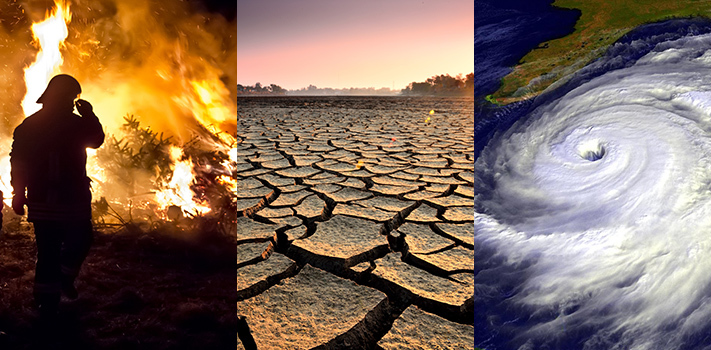Northwest. Changes in the timing of streamflow reduce water supplies for competing demands. Sea level rise, erosion, inundation, risks to infrastructure and increasing ocean acidity pose major threats. Increasing wildfire, insect outbreaks and tree diseases are causing widespread tree die-off.
Southeast. Sea level rise poses widespread and continuing threats to the region’s economy and environment. Extreme heat will affect health, energy, agriculture and more. Decreased water availability will have economic and environmental impacts.
Midwest. Extreme heat, heavy downpours and flooding will affect infrastructure, health, agriculture, forestry, transportation, air and water quality, and more. Climate change will also exacerbate a range of risks to the Great Lakes.
Southwest. Increased heat, drought and insect outbreaks, all linked to climate change, have increased wildfires. Declining water supplies, reduced agricultural yields, health impacts in cities due to heat, and flooding and erosion in coastal areas are additional concerns.
Secondly: Scientific consensus: Earth's climate is warming
Statement on climate change from different scientific associations:
1-American Association for the Advancement of Science
"The scientific evidence is clear: global climate change caused by human activities is occurring now, and it is a growing threat to society." (2006)
2-American Chemical Society
"Comprehensive scientific assessments of our current and potential future climates clearly indicate that climate change is real, largely attributable to emissions from human activities, and potentially a very serious problem." (2004)
3-American Geophysical Union
"Human‐induced climate change requires urgent action. Humanity is the major influence on the global climate change observed over the past 50 years. Rapid societal responses can significantly lessen negative outcomes." (Adopted 2003, revised and reaffirmed 2007, 2012, 2013)
4-American Physical Society
"The evidence is incontrovertible: Global warming is occurring. If no mitigating actions are taken, significant disruptions in the Earth’s physical and ecological systems, social systems, security and human health are likely to occur. We must reduce emissions of greenhouse gases beginning now." (2007)
5-The Geological Society of America
"The Geological Society of America (GSA) concurs with assessments by the National Academies of Science (2005), the National Research Council (2006), and the Intergovernmental Panel on Climate Change (IPCC, 2007) that global climate has warmed and that human activities (mainly greenhouse‐gas emissions) account for most of the warming since the middle 1900s." (2006; revised 2010)
Finally, some suggestions on how we could work together to protect our planet from this real crisis.
1-Forego Fossil Fuels—The first challenge is eliminating the burning of coal, oil and, eventually, natural gas. This is perhaps the most daunting challenge as denizens of richer nations literally eat, wear, work, play and even sleep on the products made from such fossilized sunshine. And citizens of developing nations want and arguably deserve the same comforts, which are largely thanks to the energy stored in such fuels.
2-Infrastructure Upgrade—Buildings worldwide contribute around one third of all greenhouse gas emissions (43 percent in the U.S. alone), even though investing in thicker insulation and other cost-effective, temperature-regulating steps can save money in the long run. Electric grids are at capacity or overloaded, but power demands continue to rise. And bad roads can lower the fuel economy of even the most efficient vehicle. Investing in new infrastructure, or radically upgrading existing highways and transmission lines, would help cut greenhouse gas emissions and drive economic growth in developing countries.
3-Move Closer to Work—Transportation is the second leading source of greenhouse gas emissions in the U.S. (burning a single gallon of gasoline produces 20 pounds of CO2). But it doesn't have to be that way.
One way to dramatically curtail transportation fuel needs is to move closer to work, use mass transit, or switch to walking, cycling or some other mode of transport that does not require anything other than human energy. There is also the option of working from home and telecommuting several days a week.
4-Be Efficient—A potentially simpler and even bigger impact can be made by doing more with less. Citizens of many developed countries are profligate wasters of energy, whether by speeding in a gas-guzzling sport-utility vehicle or leaving the lights on when not in a room.

Thanks, Michael, especially for the 5-point action plan. Most of us can readily implement at least a couple of them - wish I could move closer to work! - and with a vigorous educational focus we can move the next generation to implement them all. Where there are plans there is hope.
ReplyDeleteGet daily ideas and guides for generating THOUSANDS OF DOLLARS per day FROM HOME totally FREE.
ReplyDeleteSUBSCRIBE FOR FREE
Just received a check for $500.
ReplyDeleteSometimes people don't believe me when I tell them about how much you can make filling out paid surveys online...
So I took a video of myself actually getting paid over $500 for paid surveys.